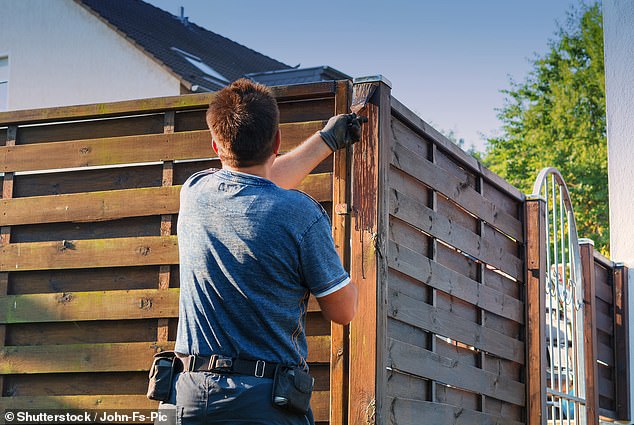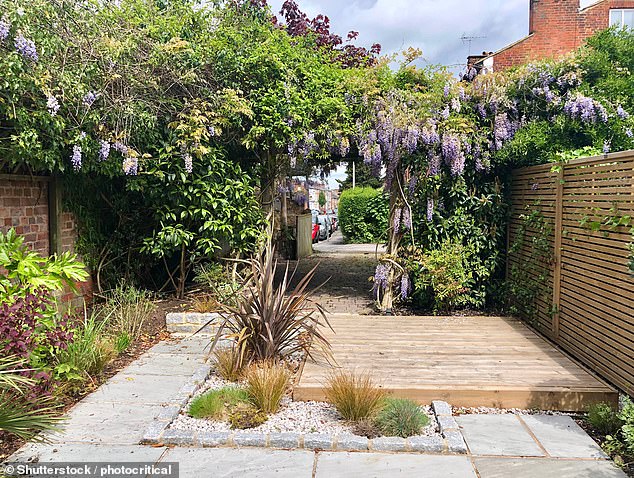Can we install a high garden fence so that the neighbors cannot overlook us?
We moved to a terraced house earlier this year and over the summer we were somewhat troubled by our garden being closely overlooked by our neighbours.
We are considering putting up a large fence around the entire perimeter of our backyard to prevent this, but we have read stories of neighbors complaining to the council about these types of fences and it concerns us.
What are we allowed to do and do we need a building permit? Via email
Overlooked: Our reader is considering installing a high fence around the entire perimeter of their backyard to provide privacy from their neighbors
Ed Magnus from This is Money answers: Garden fences often become a point of contention between neighbors.
Earlier this week it was reported that a father who had erected a two-metre high fence around his garden to protect his children could be forced to tear it down after neighbors objected to its ‘unreasonable’ height.
Talking to your neighbors should always be the first step before proceeding with any work that could affect them. After all, they may have legal grounds to object.
It may also be that your neighbors are not the only obstacle to your high fence.
You should also check if there are any rules or restrictions that affect the property itself and the area in which you live.
We spoke for expert advice about this Olivia Egdell pagea partner and head of the real estate department at the lawyers of Joseph A Jones & Co and Mike Hansoma property disputes adviser at BLB Solicitors.
Talk to your neighbor first
Mike Hansom replies: Maintaining good relations with neighbors and adhering to the law are the most important considerations when installing a garden fence.
Neighborhood disputes can be costly, and the existence of a dispute, especially if it is unresolved, can affect your ability to sell your home.
Although it is not a legal necessity, consider discussing your plans with your neighbors before proceeding.
For these purposes we assume that there is an established and clear boundary position marked on the ground.
It is important to take into account your neighbors’ potential right to light. Depending on the circumstances, a high, closed fence that replaces a more open fence may infringe on that right.
You will also need to consider your title deeds, which may contain a covenant governing the height and type of fence.
Do they need a building permit?
Mike Hansom replies: In most cases, fencing is classified as ‘permitted development’, which means that no planning permission is required as long as the fencing is no more than two meters high from ground level.
The maximum allowable height of your fencing usually includes any trellises, but check with your local planning authority as rules vary.
If your fence replaces an existing fence that exceeds the legal maximum, I do not recommend increasing the height further.

Permitted development: In most cases, planning permission is not required to erect a fence, as long as the fence is no higher than two meters from ground level.
If the fencing abuts a highway used by vehicles or the footpath of such highway, its height from ground level shall not exceed one meter.
An exception applies to fences placed within the boundaries of listed buildings and for which a building permit is required.
However, you are unlikely to need a listed building permit unless the fencing is physically attached to the listed structure.
Olivia Egdell-Page replies: The works you can and cannot carry out on your property are set out in the title of the property and also in the wider planning regime that applies to the property and area in question.
Certain areas are subject to additional controls, which may be property specific or area specific, for example if the property has been designated a Grade II listed building by Historic England or if the property is in a conservation area.

If a fence abuts a highway used by vehicles or the footpath of such highway, its height from ground level shall not exceed one meter
The rules will apply differently to listed buildings or areas of special control, so please take this into account. You were probably informed at the time of purchase if any of these designations apply to your property.
Additionally, in some cases the title to the property may include covenants or restrictions on development, including the construction of a new boundary structure, so you should take this into account before proceeding.
In addition, the title of your home may also contain information about who is responsible for the boundaries if they are shared with another home, as is probably the case with a terraced house.
What is your advice?
Olivia Egdell-Page replies: My advice would be to consult your lawyer and the local planning authority in the first instance, to confirm their requirements in the specific circumstances that apply to your property.
Some links in this article may be affiliate links. If you click on it, we may earn a small commission. That helps us fund This Is Money and keep it free to use. We do not write articles to promote products. We do not allow a commercial relationship to compromise our editorial independence.
